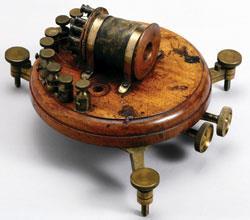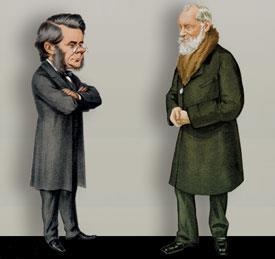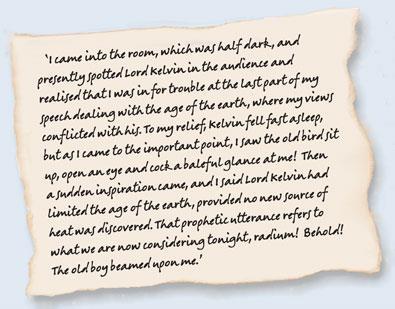In the month that marks the 100th anniversary of Lord Kelvin's death, Colin Russell unravels the life of a prodigious talent
In the month that marks the 100th anniversary of Lord Kelvin’s death, Colin Russell unravels the life of a prodigious talent

Few scientists have such an influence that they have a scale of temperature named after them, but such was the impact of the life and work of Lord Kelvin. He had the distinction of being the first scientific Briton ever to be elevated to the peerage. But when he was born, on 26 June 1824, he was plain William Thomson.
Thomson was the fourth of seven children of James Thomson, professor of mathematics at the Royal Belfast Academical Institution, who in 1831 obtained the chair of mathematics at Glasgow University. After their mother died in 1830, the family moved to Scotland, where the children were educated by their father. Thomson and his older brother James were allowed to attend their father’s lectures as very young boys - but not allowed to interrupt or answer his rhetorical questions. After this they became regular students at the university.
A precocious child, William matriculated at the University at the age of 10. He attended classes of the legendary chemist Thomas Thomson (no relation) who had early supported Dalton’s atomic theory and founded a research school in his laboratory. In 1841 William went to Peterhouse College, Cambridge, reading mathematics and eventually obtaining a Fellowship. For some months he worked in Paris, in the physical chemistry laboratory of Victor Regnault, then interested in high-pressure steam.
Early opportunity
In 1846 Thomson returned to Glasgow. At the age of just 22, he was appointed to the vacant chair of natural philosophy, which he retained for 53 years. Upon his knighthood in 1866, he chose his title, Kelvin, from the the river that ran close to the university.
His early lectures were delivered with more gravity than would be expected from such a young man, but were spiced with humour and became a great success with undergraduates. But it was in his laboratory that he broke all the rules, and began to transform science.
First, there was his understanding of the nature of ’natural philosophy’. Whereas his predecessor, William Meikleham, had more or less equated it with mechanics, for Thomson ’the fundamental subject of natural philosophy is dynamics, or the science of force’. This premise provided the basis for many of the principles of modern physics.
He also radically changed what went on in the laboratory. Previously, students had been taught by lecture-experiments which they were expected to watch. But Thomson wanted his students to perform their own experiments - many of them new. He would often join them, creating an informal research school, similar to that of his own former mentor in chemistry, Thomas Thomson.
In the laboratory he (or they) made over
30 discoveries that others had made before them. This is not so much an indictment for not reading all the literature, as an expression of the experimental exuberance with which they approached problems.

This new style of study meant that apparatus had to be replaced - the existing equipment was utterly inadequate, much being ’of worm-eaten mahogany’. So Thomson obtained delicate instruments of the necessary sensitivity from local manufacturers. The university sanctioned the then prodigious sum of ?500 for his apparatus - much of it was obtained from that other centre of excellence, once inhabited by Thomson, Paris. Later, he associated himself with a firm of scientific instrument-makers in Glasgow, and excelled in the field of electricity - developing many new instruments, including his famous mirror-galvanometer.
Finally, there was the question of where all this was to happen. The laboratory Thomson had inherited proved far too small, and extension into an adjoining room brought fierce territorial disputes with some colleagues. In due course the problem was solved when the university provided new accommodation on the floor below for what was called ’the cellar laboratory’ - one of the first to be devoted to physics research and teaching - in 1858. This represented a professionalisation of the subject, which only spread south of the border a few years later.
Energy efficiency
On the River Clyde, not far from the university, lay William Fairbairn’s famous ship-building yard, which provided marine engines for some of the new, iron ocean-going vessels. Here, Thomson’s elder brother James was serving an apprenticeship. As an engineer and as a true Scot, James was concerned about the problem of huge quantities of energy going to waste, and sought to address it as effectively as possible. Thomson, always very close to his brother, duly focused his research on energy changes, becoming one of the first exponents of the new science of thermodynamics. He had already corresponded on that subject with W J M Rankine, who obtained the Chair of Engineering at Glasgow in 1855, and thereafter was a close ally.
The first law of thermodynamics (that energy is neither created nor destroyed) had been anticipated by several researchers, not least the Manchester amateur J P Joule, who also determined the mechanical equivalent of heat. Although Joule was not at first recognised by the London establishment (as he said, ’what else do you expect from a bunch of gentlemen who eat lunch at dinnertime?’) his view was included in Thomson’s paper of 1851 on ’the dynamical theory of heat’. Here he also expounded the second law of thermodynamics, proposed by Carnot and Clausius some years before. Thomson’s own achievement was in bringing these laws before the public in a fresh manner, and also stating his conviction that heat is a form of motion. He confirmed the absolute scale of temperature which he had first established in 1848 - the Kelvin scale. At 0 K one cannot get any colder, and nothing moves at all.
The age of the Earth

Thermodynamics quickly led its new spokesman into dangerous fields, when he became concerned to relate physics to the Earth’s history. People had been speculating on the age of the Earth for over a hundred years. Was it 6000 years old as some imagined Genesis to teach, or was Charles Lyell’s minimum of 200 million years nearer the mark? Geology’s uniformitarians were inclined to vote with Lyell, but were they right? Perhaps the new thermodynamics might settle the issue.
Thomson made certain assumptions in his calculations. First, he thought that the Earth was solid throughout; second, he assumed that specific heats and thermal conductivities were roughly constant - the same as the surface rock near Edinburgh that he tested; third, he believed that the recent writings of Fourier led to a valid mathematical treatment of heat conduction. He argued that though the Earth had experienced violent upheaval in the remote past, leaving a residual volcanic activity, there was now no internal source of heat. He assumed the temperature at the centre of the Earth was about the melting temperature of rocks at the surface, and so obtained a temperature gradient from core to surface.
Using known heat conductivities for the rocks, he was able to calculate the rate of heat loss and thus to extrapolate to the beginning. The methodology, though all too briefly summarised here, was surprisingly sophisticated. His first result was about 400 million years but, as underground temperatures became more known, his calculations led him to suggest 50 million years in 1876, and much less thereafter. He was advised and supported by John Phillips, the Oxford geologist.
These results emerged at the height of the controversy over evolution. The periods were much too short for Darwin. They were not inconsistent with evolution itself, but did clash with Darwin’s own estimates of at least 300 million years, on the basis of erosion of rocks such as chalk.

The ensuing conflict has been much discussed, and Huxley’s role in particular as defender of Darwin. But Thomson relished a good fight and was not rebuffed. His arguments were finally dismissed by the discovery, late in the 19th century, of radioactivity, a source of internal heat of which Thomson was quite unaware. In 1904, now Lord Kelvin, he attended a lecture at the Royal Institution by Ernest Rutherford - the speaker’s recorded comments provide a wonderful insight into Thomson’s character.
Immediately after this, the two men were staying together as guests of Lord Rayleigh and the conversation was both intense and amicable. Thomson, ’the old boy,’ had the grace to accept the force of Rutherford’s arguments, and the sense to see the strength of new evidence. But he held to the doctrine of a relatively young earth, and regarded this as his most important contribution to science.
Electricity and telegraphy
Thomson had long been interested in electricity, and was fascinated by the work of Faraday whom he visited. The origins of magnetic field theory have been variously attributed to both men, and at the very least Thomson must be seen as an encourager of Faraday. He studied contact electrification in the early 1860s and addressed the Royal Society on the subject in 1897.
Perhaps Faraday’s lecture of 1854 prompted him to republish some earlier material, showing how Fourier’s equations applied to both heat-flow and the distribution of electric potential. He had, meanwhile, several contacts with cable manufacturers in Glasgow, and became sufficiently interested and informed in questions of conduction in cables to join the Atlantic Telegraph Company, an ambitious Victorian project funded by governments in Britain and the US, that would lay the first submarine transatlantic telegraph between the two countries.
The cable, first laid in 1857, did not survive for more than a year, and controversy raged within the company as to the cause of the disaster. Once again Fourier’s methods were called upon by Thomson, and indicated a falling-off of signal strength with increasing length of cable. Thomson’s laboratory testing of the copper used in the cables showed the importance both of its quality and heaviness. His contributions were controversial, but they did secure for him a knighthood and a significant financial reward. In 1870 he purchased a large schooner yacht, the Lalla Rookh, which became a floating laboratory and also a showpiece for his delicate measuring marine instruments.
A chemistry legacy
Although primarily a physicist, Thomson has left chemistry deeply in his debt. With Helmholtz, he injected his whole idea of energy into all chemistry.
His propagation of thermodynamic laws has brought entropic changes within the view of anyone who carries out a chemical reaction. Free energies are no longer part of obscure mathematics of no interest at the bench. He debated the connection between osmotic pressure and other electrolytic phenomena. Using the mechanical equivalent of heat he calculated with great accuracy the electromotive force in a reaction, and the precise voltage for, for example, the electrolysis of water. He studied the Peltier [reversible heat] effect, and much else.
Thomson’s views on atoms varied with time. The hard spheres, used as models by organic chemists, were frowned on as mere legacies from the Greeks. He inclined more to the idea of Helmholtz that they might be vortices in a perfect fluid - presumably the ’ether’ that was then a popular concept. A machine invented by his friend Peter Tait made smoke rings or tangible vortices which further convinced him. Thomson’s views carried much weight and seriously inconvenienced the classical atomic theory. By the 1880s he had severe doubts on the ability of vortex theory to explain all of chemistry and said little further about it. He accepted ’electrions’, later rechristened ’electrons’ by their discoverer J J Thomson. In the end he tended to view atoms as a mass of positive electricity in which these (negative) electrons were embedded.
Kelvin’s world view
In his day Thomson was the acknowledged leader in British science - perhaps the greatest scientist of Victorian Britain. He was President of the Royal Society from 1890 to 1895. He constructed a mansion at Largs, Netherhall, overlooking the Clyde, and, in 1892, was raised to the rank of Baron Kelvin of Largs. He married twice but had no children, so with his death at home in 1907 the baronetcy disappeared.
Although he was undoubtedly motivated by a concern for wealth and position, as suggested by his involvement with industry, it would be na?ve to suppose that this was all that drove him. Neither was he a political animal - though he did have a strong sense of the British Empire, which is why he opposed Home Rule for Ireland and why he was so glad to link nations together with the cable. We know from his private papers a great deal about his religious views. His lecture notes from student days; some private notes to himself about the end of the age; his lectures to his own students: all point to a man who inherited the traditions of his family - a mild Ulster Protestantism - and a Biblical theism then common at Glasgow University. He was not a denominationalist, attending Anglican, Presbyterian or Free Church of Scotland services according to where he happened to be.
His science was informed by his theology - an examination of the world as God had made it. Scientific laws as well as miracles were part of the picture. He was not against evolution as such, but he opposed Darwin for his abandonment of purpose in the universe. He even praised William Paley’s classic Natural Theology, calling it ’that excellent old book’. Beyond this simplified picture of a notable Scottish scientist may be discerned a man of strong Christian faith who saw in the operation of thermodynamics, as in the creation of the Earth, the all-powerful hand of God.
Colin Russell is emeritus professor of history of science and technology at the Open University, Milton Keynes, UK






No comments yet